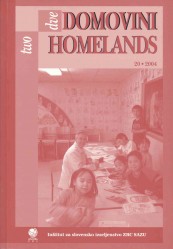WHAT, HOW AND MAYBE WHY THEY WROTE SO ABOUT EMIGRATION AND EMIGRANTS FROM VENETIAN SLOVENIA IN THE NEWSPAPER MATAJUR IN THE YEARS 1951-1960
Abstract
My attempt was to demonstrate in the contribution what significance a group of the “advanced” gathered around for years long only newspaper of Julian Slovenes, the Matajur attributed to emigration – a “number one” phenomena in decades after World War II in Julian Slovenia. (Julian Slovenia, a region in the northeast of Italy is the most Western part of “Slovene-speaking” territory; its several-centuries political-administrative isolation from other “Slovene-speaking” regions demonstrates in particular identity and culture of its inhabitants). When analysing newspaper contributions from the appearance of the newspaper in October 1950 until the end of 1960, I was looking for contents, which occur on the following three dimensions of communication: selection of the reported reality, attitude of the information towards reality, and linguistic presentation of the information. I named contents that occurred in all three stated fields, motives. I defined motives as a “message/report cliché”, which has in presenting certain content, problematic, a specific attitude towards reality and a specific linguistic presentation of the information. Motives are thus carriers of particular manners of representations of (individual) events, occurrences, phenomena.
With the occurrence, existence of motives I have shown that particular styles of representation of phenomena exist, in the dealt case emigration, and that those form the special meaning of a phenomena (emigration). The existence of motives indicates that emigration was not at all dealt with impartially. The language of power (and resistance), exploitation, discrimination, social inequality and much else interfered in the presentation of this social phenomena. Emigration was in the mentioned period a metaphor for exploitation, inequality; it reflected a subordinate, neglected position of Venetian Slovenes and was as such by the writers of the treated texts evaluated most negatively. Towards the end of the mentioned period a motif of the emigrant occurred, inspired by the “revolutionary iconography”, the worker as carrier of long anticipated change and new era. Emigration thus gained from the side of text writers a new no longer “pessimistic” but “redemptive” significance.
I conclude the article ambitiously: with a presumption that (proof on) existence of motives can enable good foundations for deliberation and theorization on social structures and on functioning in (journalistic) communication that is “writing”. To the reproach why I answer given questions with questions, I say: Why not?
Downloads
References
Cerno, Guglielmo (1 968). Aspetti geografici del fenom eno migratorio in nove communi della cosidetta »Slavia Friulana«. Urbino: Facolta di Lettere e Filosofia [diplomska naloga].
Clavora, Ferruccio in Ruttar, Riccardo (1985). Sloveni ed emigrazione. 1/ caso delle valli del Natisone. Cividale del Fruli: Zveza Beneških izseljencev.
Clavora, Ferrucio in Ruttar, Riccardo (1993). The community without a name. Premariacco - Udine: Zveza Slovenskih Izseljecev Furlanije - Julijske krajine/Unione Emigranti Sloveni del Friuli - Venezia Giulia.
Fielding, Tony (1 992). Migration and Culture, Migration Processes andP atterns. Volume I. Research Progress andProspect, (uredili Tony Champion, Tony Fielding). London: Belhaven Press, str. 201-212.
Drnovšek, Marjan (2003). »Izseljevanje je rakrana na telesu našega naroda«, H istorični sem inar 4, (uredili M etoda Kokole, Vojislav Likar, Peter Weiss). Ljubljana: Založba ZRC, str. 7-33.
Gariup, Renzo (2000), Emigrantova žalost. Trinkov koledar 2001, str, 236-237,
Geertz, Clifford (1973), The Interpretation o f Cultures. New York: Basic Books,
Giddens, Anthony (1995), The Constitution o f Society. Cambridge: Polity Press
Habermas, Jiirgen (1975), Saznanje i interes. Beograd: Nolit.
Kalc, Aleks (1994), Smernice preučevanja izseljenstva v slovenskem zamejstvu v Italiji in slovensko izseljevanje iz zam ejskega prostora v delih italijanskih avtorjev, Dve domovini/Two Homelands, 5, str, 151-178,
K alin G olob, M onika (2003), Stil in novinarski škandal, Teorija in praksa, 40, 2, str. 229-244.
Komac, Miran (1990). Politična kultura. Narodnostna identiteta, migracijski procesi in etnorazvoj. Protislovja narodnostnega razvoja Slovencev v Videmski pokrajini. Ljubljana: Fakulteta za sociologijo, politične vede in novinarstvo [doktorska disertacija].
K orošec, Tomo (1998), Stilistika slovenskega poročevalstva, Ljubljana: Kmečki glas,
Košir, M anca (1988), Nastavki za teorijo novinarskih vrst, Ljubljana: DZS.
Luthar, Breda (2003), Uvodnik, Teorija in praksa, 40, 2, str, 205-206,
M eneghel, G iovanna in Battigelli, Franca (1977). Contributigeografici a lh studio dei fenom eni migratori in Italia. Analisi di due comuni campione delle Prealpi giulie: Luserva e Savogna. Pisa.
Petricig, Paolo (1988), Per un pugno di terra slava. Trieste: Editoriale stam pa triestina.
Petričič, Pavel (1997), Pod senco Trikolore. Špeter: Zadruga Lipa,
Stranj, Pavel (1999), Slovensko prebivalstvo Furlanije-Julijske krajine v družbeni in zgodovinskiperspektivi. Trst: SLORI, Narodna in študijska knjižnica in Znanstveni inštitut Filozofske fakultete Univerze,
Vovko, Andrej (1989). Izseljensko vprašanje v koledarjih družbe sv, Cirila in M etoda, Kronika, 37, 3, str. 278-286,
Zuanella, Božo (1998). Mračna leta Benečije: dejavnosti tajnih organizacij v vzhodni Furlaniji. Ljubljana: Cankarjeva založba,
Downloads
Published
How to Cite
Issue
Section
License

This work is licensed under a Creative Commons Attribution-NonCommercial-NoDerivatives 4.0 International License.
Authors guarantee that the work is their own original creation and does not infringe any statutory or common-law copyright or any proprietary right of any third party. In case of claims by third parties, authors commit their self to defend the interests of the publisher, and shall cover any potential costs.
More in: Submission chapter





